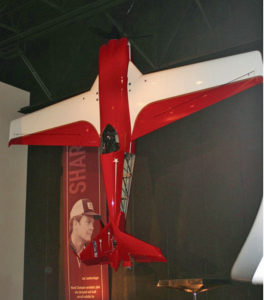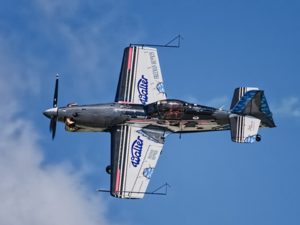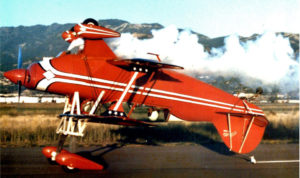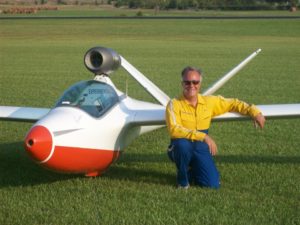Almost from the beginning of powered flight, the airplane has been used to entertain. And what we think is new and different in today’s air show world, likely as not, was first done decades ago. What has changed is technology. And with each technological improvement has come new opportunities, both to embrace the changes and move forward, as well as to harken back in time.
The Wright brothers’ first flight was straight ahead. Imagine the thrill when they perfected wing warping that allowed an airplane to make a controlled turn. Wing warping gave way to newfangled devices called ailerons as turning became the norm. Then, along came Lincoln Beachey, who figured out how to do a loop. And the rest is history.
Lincoln Beachey, because of his daring stunts, became one of the highest paid entertainers in America (ah, for the good old days). Sitting out over the nose wheel with his massive V-8 pusher engine behind him, his aircraft looked more like a box kite on steroids than an airplane. He was acclaimed, in part, because he would fly his lumbering stick and fabric machine to altitude and push the nose straight down, pulling out, it was said, a scant 50 feet above the turf.
While there is no way to know the precise altitude at which he would pull out, this one stunt alone helped propel Beachey to the forefront of the entertainment world. As other pilots tried to emulate Beachey, they learned the hard way that he knew something they didn’t. And, eventually, even Beachey himself pushed the envelope too far and died in a tragic crash.

Before there was Smoke-n-Thunder, before there was Shockwave, and before there was a jet-powered school bus, the hottest race car driver on the planet, Barney Oldfield, was challenging Beachey to races at air meets and other events all across the country. Oldfield was the first man to coax a car up to 60 miles per hour and was every bit the showman as Beachey. When the two were on the same bill, a paying crowd was assured. Innovative for its day. Commonplace today.
As science and engineering began to be applied to aircraft design, there came a better understanding of aerodynamics, center of gravity and all the forces of lift, drag and thrust that affect how airplanes fly. Amateur homebuilders and fledgling startup companies led the development of flying machines, but most of the significant advancements in early aircraft and power plant design in the first half of the 20th century came during World War I and World War II, as countries pressed designers to develop faster, stronger and more lethal flying machines. As these wars wound down, many of these military aircraft became surplus and started showing up in air shows, further fueling the public interest in aviation and air shows.
Innovation has fueled innovation within the air show world, but — unlike auto racing — air shows have had little opportunity to spin off their advancements to other aspects of aviation. For example, the quest for speed and efficiency in auto racing has given us the clutch-less manual transmission, four-wheel independent suspension, high-performance tires, disc brakes, the dual overhead cam engine, and the list goes on. The closest that any performer has come to advancing general aviation technology was seven-time U.S. Aerobatic Champion Leo Loudenslager.
To say that Loudenslager was obsessed with development of a world-class airplane and flying the perfect routine is a serious understatement. The former B-52 mechanic bought a Stephens Akro kit in 1970, when he emerged from the U.S. Air Force and competed in his first aerobatic competition a year later. He then set about modifying his Akro by removing every bit of weight that he could.

“He shaved every part down to the bone and literally tossed out most of the original Stephens Akro design. He rebuilt everything and refined the engine so he could pull the airplane through all the tumbling and violent maneuvers that we are so used to today,” said Dorothy Cochrane, Curator of General Aviation, Aeronautics Department at the National Air and Space Museum in Washington, D.C.
By the time Loudenslager finished his modifications, only about ten percent of the original Akro airplane remained, evolving into what he dubbed the Laser 200 and named his “Beautiful Obsession.”
Loudenslager was on the forefront of American monoplane design, having little interest in the popular Pitts Special biplanes that had swept the industry. “The Laser had wood wings, and the one-piece wood spars were becoming hard to come by. We had built and sold over 20 wood wings for the Stephens Akro, but we were being encouraged to make composite wings and the material was becoming more affordable. Extra had come out with a composite wing which pushed us to develop the Edge 540,” said Eric Zivko, President of Zivko, the company that designed and built the Edge 540.
As Loudenslager worked with the folks at Zivko to develop wings for the Edge, an idea for a revolutionary new design began formulating in his mind which led to development of the one-of-a-kind airplane that he dubbed the “Shark.” “The Shark was ahead of its time. Leo’s goal was to develop his version of the ultimate airplane and it took a year of talking between us to decide how to do it, followed by another year of testing. The result was revolutionary,” Zivko said.

The Shark used carbon fiber tubing joined with welded titanium clusters. When finished, the fuselage weighed only 38 pounds, compared to 82 pounds for the standard Edge 540 which uses steel tubing. “Every part of Leo’s Laser that was not structural was drilled full of holes to make it lighter and all of the aluminum fairings and cowling were very thin. He carried this mentality into the design of the Shark,” Zivko said. The Shark incorporated composite wings and control surfaces, as well.
And, as light and agile as the plane was destined to be, its most unique feature was the tail section. Both the horizontal and vertical stabilizers could be uncoupled, giving greater stick throw and 70 degrees of deflection during flight. “Leo’s intention was to be able to use power to go vertical, and then continuously flip the aircraft end-over-end, pivoting around the wing tips,” said Zivko. In addition, the airplane was to use a brand new Lycoming engine design and a composite Hartzel prop that would give a thrust-to-weight ratio exceeding one to one. Producing 1,480 pounds of thrust and an empty weight of 860 pounds meant Loudenslager could also accelerate vertically.
Unfortunately for Loudenslager and for the air show industry, the Shark never flew. Just a month before it was to be completed, Loudenslager suffered fatal injuries when the motorcycle he was riding was struck by a car near his home in Tennessee. He was hospitalized and never regained consciousness. “[On] the morning of the accident, the wing was in the paint booth and we were preparing for the final assembly of the Shark when Leo’s family called us and asked us to hold off. We never finished it and it was eventually donated to the Experimental Aircraft Association museum with covering on only half the fuselage so the tail linkage construction would be visible. We would have loved to see it fly, but it was so revolutionary that Leo was the only logical choice to be the pilot,” Zivko said.
In spite of the Shark never taking to the air, Zivko said newer airplanes are nearly capable of what Loudenslager wanted to do, so his influence continues to be felt.
While the passion for innovation took Leo in one direction, that same passion took Wayne Handley in a similar, but separate direction. Handley, who operated a crop dusting operation for many years, had gained fame flying competition as well as air shows in a four-cylinder Pitts, at a time when Pitts aircraft were dominating the industry. He was successful, but he wanted something different.
“I was at the national aerobatic championships in Texas in 1988, when I met Bob Jones who was selling a kit called the Rebel 300. It was a six-cylinder monoplane and there was only one monoplane in competition. I was able to work with Jones to design the modifications that I wanted. We stretched it enough to install a second seat and called it the Rebel 2300. It took me two years of work to be able to fly it at the same level of proficiency that I had flown the Pitts. I was able to develop new maneuvers and worked a lot with Sean Tucker to perfect a completely new act,” Handley said.
But, along the way, Handley was nagged by the idea of doing something unprecedented to improve his brand. “I came up with the same idea that Leo had…develop an airplane with a positive thrust-to-weight ratio.” And, with that concept, the idea for the Turbo Raven was born. “I wanted to be able to go vertical, hang it on the prop, then go up again,” he said. A simple idea, but not so simple to implement. “An idea stays a dream until you write it down and develop a plan to make it happen,” Handley said.
Like Loudenslager before him, Handley turned to Zivko for help. Working with Zivko engineers, Handley was able to commit his dream to paper and designed a new airplane that would use a turbine engine that produced one thousand horsepower. But there was one big obstacle. While the design was there, the engine wasn’t. “The company I turned to for the engine wasn’t interested and gave me no help, so I had to find something different,” he said, and the project stalled. But his dream didn’t.

Eventually, Handley found an engine that produced 750 horsepower and it all came together. He found a sponsor who would back him, stirred tremendous interest in the air show community, and his dream became a reality. Handley’s first year with the Turbo Raven was very successful, right up until a mechanical problem with the propeller caused him to pancake, while performing in Salinas, California, in 1999. Even though he proved the concept worked, the Turbo Raven never flew again. He has been approached several times to build a new, better version of the airplane, but has declined. “It won’t be me, but there is tremendous entertainment value in such an airplane for anyone who wants to pursue it,” he said.
Heart surgeon Ray Vetsch of Joplin, Missouri may just be the one to do it. He had similar dreams when he fitted a turbine engine onto a Sukhoi a few years ago. The results were impressive and his act has been well received wherever he has flown. “It is an incredibly powerful airplane. The engine produces 3,400 pounds of thrust against a gross weight of 2,200 pounds,” Vetsch said.

While good in concept, Vetsch said there were problems initially. The first engine he tried had issues going inverted and even vertical. “I overcame that problem when I turned to the Walter Engine Company, as they had developed an engine for Eastern Bloc countries that could provide power in all positions. We learned from Wayne’s experience and were able to develop an airplane with an incredible performance envelope. You point it at the sky and it goes there,” Vetsch said.
Like Handley, Vetsch started flying air shows in a Pitts. Then he moved up to the Sukhoi and added the turbine engine. “It’s different than a flip-flop airplane. I’ve copied some of Wayne’s maneuvers and learned not only what to do, but what not to do. Many people are quick to offer ideas for maneuvers, but some of them can really get you into trouble,” he said.
One of the most innovative pilots in the air show business was the late Jimmy Franklin. He was one of the first, with his Zar routine, to adopt a theme for his act. He was well known for his WACO Mystery Ship routine, and just as popular with stunt man Johnny Kazian walking his wing or transferring from a speeding motorcycle or car onto a rope ladder slung beneath the WACO. Jimmy would then fly him around the field and sling him into a fire wall where he would emerge unscathed time after time. Crowds loved it. Jimmy was also the only pilot willing to do lomceváks, tail slides, torque rolls and snap rolls with a wing walker on the top wing.

“When Dad developed Zar, there was skepticism about anyone liking it. He was trying to capitalize on America’s fascination with space flight and the Star Wars movie. It turned out to be the hottest thing in the air show industry,” said Jimmy’s son, Kyle Franklin. Zar wore a black costume with a cape and a black helmet obscuring his face. Kids would flock to him when he landed, demanding his autograph. Before long, other performers began to try costume ideas to add a new spark to their routines. “Dad’s ideas helped the industry get away from the jeans and t-shirts that most pilots wore. And today, there is a lot more creativity in costumes and flight suits than ever before,” said Kyle.

Then Jimmy did something totally unexpected. With the help of Les Shockley, he lashed a jet engine to the belly of one of his WACO biplanes and put it out there at the 1999 ICAS Convention for everyone to see. Unfortunately, even among the shows who knew him well, the industry wasn’t ready for such a radical idea and Jimmy booked very few shows that year. But the shows that did take a chance on this new idea were glad they did. It didn’t take long for word to get around that Jimmy had a winner and soon he was riding a new wave of popularity that is emulated today by John Klatt’s organization flying the Sasquatch.
Kyle is an accomplished performer in his own right and, learning from his dad’s vision to adopt contemporary themes developed his Pirated Skies act, capitalizing on the popularity of the Pirates of the Caribbean movies that starred Johnny Depp. “Unfortunately, this industry does not embrace change well. I went through some of what Dad experienced. Initially, there was reluctance to hire us,” Kyle said. But it didn’t take long for the industry to catch up and the Franklins were again in demand all across the country. “Pirated Skies was a big biplane act that evolved into the hottest act of 2010,” he said. Kyle did many of the same maneuvers as his father…torque rolls, tail slides, snap rolls, all with his wife, Amanda, on the top wing. He and Amanda concluded their act by crossing swords on the final pass, a simple idea that became an iconic symbol of imagination and contemporary interest.
As Kyle has matured in the air show business, he has maintained his quest to try new things…not so much to reinvent himself, but to stay current.
“Right now, most shows are still doing what they did 30 years ago,” Kyle says. “It bothers me that we are so far behind the times. We have to step up our game and find unique opportunities. We have to compete with high-tech movies, video games and an assortment of other entertainment options. Technology has advanced, but there are fewer and fewer variety acts and we need more.”
There are no rewards in this business without risk; and most of the risk, especially the cost, falls on the shoulders of the performers. If shows are reluctant to hire them, there is little incentive to try something new or different. A rare exception was Craig Hosking and the airplane he called Doubletake, a Pitts S-2 with a robust set of landing gear mounted to the top wing. Not since Mike Murphy in the years prior to World War II had a pilot fitted an airplane so it could take off and land upside down. It was the mid-1980s and, almost from the moment Hosking’s promotional literature started showing in air show mail boxes (the Internet didn’t yet exist), the bookings started coming in.
The inspiration for Doubletake came from Hosking watching Jimmy Franklin fly his WACO at the Reno Air Races. “Jimmy did an inverted ribbon pickup with the tail of his airplane and I knew right then and there that I wanted to learn to do that. Only it seemed to me that if I was going to fly that close to the ground upside down, I should be able to land that way.” So he bought a Pitts and set out to make his dream come true.

Hosking started flying conventional aerobatics with his Pitts to gain air show experience and get his low level waiver. Then the plane went into the hangar where he installed landing gear to the top wing. He wanted to stay active in air shows while he was working on the airplane, so he created Otto, the helicopter act that evolved into one of the most popular air show acts in the world. “I stayed mostly in the western U.S. with Otto the first year, then started branching out as popularity of the act grew,” Hosking said. But he always intended that Otto would be a stop gap act until the Pitts was ready to fly.
Even though installing landing gear on top of the airplane had been done before, Hosking had no knowledge of it. There was no Internet, and Hosking did as much research as he could to see if anyone else had ever done it before, but he found nothing. Only later did he learn that Mike Murphy had done something similar using a monoplane. The industry was more than ready for Doubletake. Hosking soared to prominence in his first year and very quickly received the Art Scholl Memorial Showmanship Award.
Part of Hosking’s motivation for an act like Doubletake was to move the air show industry more toward family entertainment and away from so much of the hard core aerobatics that most other pilots were doing. “Both Otto and Doubletake were intended solely for entertainment, using an aerial stage. I was delighted to see acts like Zar, Smoke-n-Thunder, and the addition of pyro and more theatrical acts rather than just pilotage,” he said.
Soon the sirens of Hollywood lured Hosking away from air shows. Today, he flies for the movie industry where he has worked on a wide variety of shows including Interstellar, Fast and Furious, Indiana Jones and many television commercials.
Innovation has also contributed to one of the best known glider acts in the air show business. Bob Carlton fitted his Salto sailplane with a small jet engine, not to increase crowd appeal, but, for practical reasons.

“I performed as a straight glider act for 13 years, but often had to struggle to find tow pilots at some of the shows,” Carlton said. While a lot of airports have glider clubs on the field and have someone with a tow plane, Carlton said he found that tow pilots were reluctant to give up a weekend of towing regular customers just to tow his glider once a day during the show.
His solution was to turn to the model airplane industry. “I started out using two model airplane jet engines, and it worked, but barely. I had to launch 20 minutes early to get to altitude to start my routine. It became obvious that the concept worked, but I needed a bigger engine,” Carlton said.
He started searching and found what he was looking for from PBS in the Czech Republic. “This little engine gives me 250 pounds of thrust which is more than enough for my needs.” Originally designed for use in auxiliary power units for Russian fighters and helicopters, the company was looking for new markets. “I came along just as they were coming to market with it,” he said.
Carlton notes he wasn’t the first to mount a jet engine to a glider. “It was done in Italy several decades ago,” he said. And others had mounted jet engines on their gliders to keep them in the air, but the engines were not powerful enough to launch the aircraft.
To date, Carlton has built two jet powered gliders and is building a third one for a friend. He sees himself as part of an evolution. “Earlier efforts were plagued by heavy engines that were old and unreliable. They were complex and hard to start. Modern equipment is clean, simple, sophisticated and reliable,” he said.
“One of the problems with innovation is how hard it is to get the word out. A sailplane act can be a bit hard to sell, and a jet sailplane even harder. The more outrageous the idea, the more difficulty there is getting it accepted,” Carlton said.
Carlton said there are additional innovations still to come from his shop, but he’s mum on what they will be. He laments that newer, younger pilots generally don’t share the zeal for innovation that is felt by some of the older pilots. “We’ve seen a shift in pilot culture. Older pilots built their own airplanes, worked on them, designed them. Today, most new air show pilots buy a production airplane and do little or none of the work on them,” he said. Carlton believes the industry needs to break that mold and get pilots thinking about new ideas, or even resurrecting old ideas with a new twist. “The opportunities are there. We just need to take advantage of them.”








